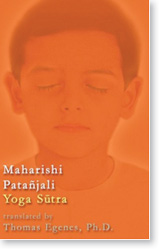
While yoga is generally understood in America to be a diverse array of bending and stretching exercises that originated in India, the word yoga has a much wider connotation, and includes sitting with the eyes closed in silent, deep meditation. In India, yoga is a state of mind, not just an exercise for the body.
The primary text on yoga is called the Yoga Sutras of Maharishi Patanjali. This text includes 195 short aphorisms, called sutras.
The second sutra of the Yoga Sutras defines yoga. In Sanskrit, it reads like this: yogash chitta-vritti-nirodhah. In English, “Yoga is the complete settling of the activity of the mind.” (Yoga is the complete settling (nirodha) of the activity (vritti) of the mind (chitta).) This is considered to be the classical definition of yoga.
Patanjali’s Yoga Sutra defines the depth of this experience as samadhi. Samadhi is a state of mind where there are no thoughts and there is no object of meditation, where the mind is fully expanded and in a state of “pure unbounded awareness.” Although for centuries scholars in the East and West had thought of this experience as extremely difficult to achieve, our generation has witnessed a remarkable new appreciation for the naturalness of deep meditation as a result of the teachings of Maharishi Mahesh Yogi, the Vedic scholar and sage who brought to light the technique of Transcendental Meditation.
I think of attempting to meditate as something like learning how to swim. A beginner might be inclined to use too much effort, and thrash around in the water. But with proper instruction, you learn to relax in the water, take smooth strokes, and glide without effort. With proper instruction meditation is just as effortless.
Those familiar with the Yoga Sutra know that samadhi is something that is not achieved in isolation. It is the last of the eight limbs of yoga, called ashtanga yoga (ashta means ‘eight’ and anga means ‘limb’). The last three limbs (dharana, dhyana, and samadhi) have to do with meditation. I believe that most systems of meditation are good at dharana, but very few understand dhyana.
Let’s go into this a bit. Dharana is usually translated as concentration or steadiness. It is taking an object of meditation, such as a mantra, and focusing on it, usually by mentally repeating it over and over. It’s like focusing on individual drops of water, because the object of meditation is discrete. Dharana is a surface state of mind, and it is unlikely that a person could slip into samadhi from the state of dharana.
Dhyana is much different. It involves a lack of focus, a lack of effort, a lack of concentration. In dhyana the object of meditation is non-discrete. While dharana is like individual drops of water, Dhyana is a continuous flow, like oil on glass. This is where Transcendental Meditation comes in as a method of proper understanding and practice of meditation. TM allows a student, right from the beginning, to achieve dhyana and then experience samadhi on a regular basis. Sometimes even on the first day of TM practice a person will say, “It was so easy and silent and simple — my mind was in a perfect state of peace without any effort on my part.”
For the past twenty-five years I have been teaching at Maharishi University of Management, an institution of higher education where all students, faculty and staff practice yoga and Transcendental Meditation as part of a traditional university curriculum. It’s been incredibly fulfilling to see my students begin their study of yoga and meditation with the effortless, natural achievement of the state of Samadhi. It provides an ideal foundation for the study of yoga in all its facets.
Of course, all aspects of the limbs of yoga are fascinating—the five yamas, the five niyamas, asana, pranayama, pratyahara, dharana, dhyana, and samadhi. None are difficult to understand and practice, and the rewards are significant. Pretty much everything a person can think of can be achieved by the practice of yoga. Settling the mind, establishing peace, and then desiring and acting from that deepest level of intelligence and the experience of vibrant, holistic health and happiness are all the natural result of successful practice of this ancient science of life. I look forward to writing more about the different dimensions of yoga in the weeks ahead. More coming!
_________________________________________
Thomas Egenes received his B.A. from the University of Notre Dame and his M.A. and Ph.D. from the University of Virginia. He is Associate Professor of Sanskrit at Maharishi University of Management in Fairfield, Iowa, U.S.A.
Dr. Egenes is the author of Introduction to Sanskrit, Part One and Part Two, and a newly released translation of the Yoga Sutras, called Maharishi Patanjali Yoga Sutra.






